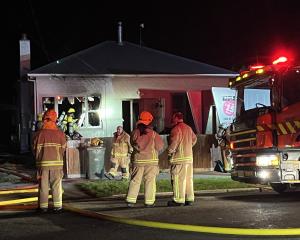An Oamaru woman who lost her husband to an asbestos-linked cancer is taking legal action against ACC.
Lois Gilchrist is fighting to have husband Rodney Gilchrist's oesophageal cancer linked to the asbestos he was exposed to during 21 years working at the old Oamaru Hospital as an orderly and general handyman, and later as a caretaker of the building from 2000 to 2007, during which time the couple and their son lived on site.
An independent medical report Mrs Gilchrist commissioned on her husband's case said he was aware some asbestos removal was done early in his time at the hospital.
The Department of Labour (now Worksafe) issued a prohibition notice to then owner Goodland Group in late 2005 after it found employees were probably being exposed to asbestos fibres in the air during demolition work on the site.
Mr Gilchrist was diagnosed with oesophageal cancer in June 2014 and died, aged 56, in February last year.
At Mrs Gilchrist's request, ACC has twice - the last time in April - reviewed its original decision to decline a claim to cover Mr Gilchrist's oesophageal cancer.
In both reviews it upheld its decision to decline the claim.
Mrs Gilchrist said while upset with the process, she believed the ACC was close to accepting her argument.
She said she had engaged lawyers and was preparing to appeal ACC's decision.
ACC could not connect the asbestos exposure to the cancer that killed Mr Gilchrist, she said.
"They were pretty close, but there wasn't enough medical evidence at this stage, but there will never be if people like me don't pursue it.''
It bothered her that organisations accepted smoking caused cancer, yet she had to battle to get her husband's exposure to asbestos connected with cancer.
"No-one bothers to look at what you've been working with for 20 years.''
In a statement, an ACC spokeswoman said the corporation fully considered the circumstances of the Gilchrist claim and determined cover could not be provided under the legislative criteria for work-related gradual process, disease or infection.
"Our decision was based on clinical advice.''
The matter was pending an appeal hearing and it was inappropriate to discuss any other details of the case until the judicial process finished, she said.
The Goodland Group, owner of the old Oamaru Hospital site, employed Mr Gilchrist as caretaker and maintenance man.
David Liu, Former Goodland Group employee and site manager at that time, said Mr Gilchrist was employed by the company from April 2004 to December 2007.
"His main task was the outdoor upkeep of the property, but he came to us with the knowledge of the buildings and property, as he had worked there previously in its time as a hospital for 21 years, and apparently assisted at the end in the removing and clearing of all property from the hospital.''
He understood Mr Gilchrist did not work on clearing asbestos from the building during the period he was employed by the Goodland Group.
"He knew about it - and did not want to touch it.''
Any clearance of asbestos at that time was completed under the strictest of conditions, Mr Liu said.
Staff were trained to work with hazardous materials and workers provided with appropriate clothing and tools, although Goodland Group contracted out the majority of the asbestos clearing work to a secondary company.
The Southern District Health Board was unable to answer any questions before the publication of this article.
Mrs Gilchrist said she was not ready to let go of what happened to her husband.
She felt she needed to raise awareness about the potential risk of working in buildings containing asbestos, especially given the present demolition work under way at the old Oamaru Hospital site.
She wanted everyone who worked on potential asbestos sites, or anyone who might be exposed to asbestos, to register themselves on the Asbestos Exposure Database.
"If you've been exposed, get it out.‘‘Get it out on the register.
"If you don't, 20 years down the track you're on your own.''
The cancer that killed her husband was a slow but progressive development that would have taken years to show itself, she said.
Before Mr Gilchrist was diagnosed they both knew something was wrong; "even his smell had changed''.
The way her husband died was cruel, Mrs Gilchrist said.
Asbestos
• Asbestos-related disease is the No 1 killer in New Zealand workplaces.
• Despite increased awareness of its dangers, more than 170 New Zealanders die each year (on average) from diseases stemming from exposure to asbestos.
• The time between exposure to asbestos and development of disease can be decades long.
• Due to its strength, durability and resistance to fire and water, asbestos was widely used in building products and materials up until the 1990s.
- Source: WorkSafe New Zealand













